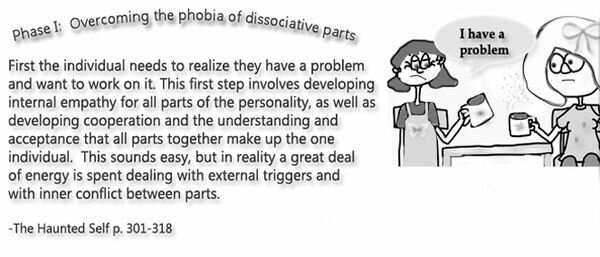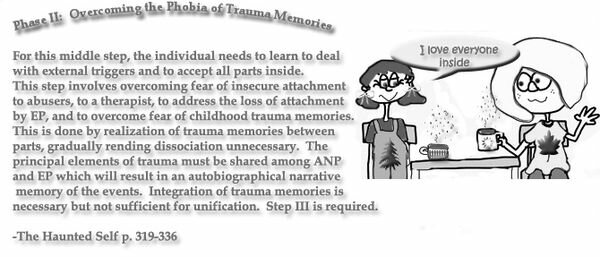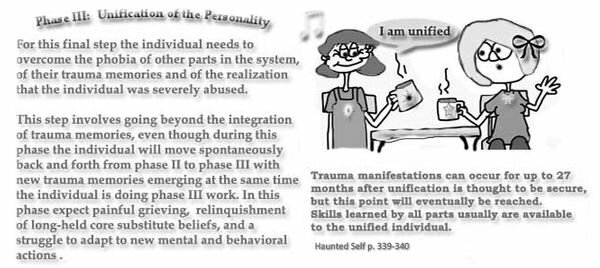Integration
Integration is an ongoing process that an individual can choose to work on throughout their life. The methods are detailed in Dr. Sielgel's work. [1] This page however, will focus on integration and unificationAlso known as final fusion. See 'integration'.Integration (state of unification) occurs in the minds of all individuals and is a process rather than an end product. "If integration is impaired, the result is chaos, rigidity, or both. Chaos and rigidity can then be seen as the red flags of blocked integration and impaired development of the mind." {{Rp|9}} The natural process of the mind is to link differential parts (distinct modes of information processing) into a functional and unified self. No child has unified personality when born, in fact, they need years of sufficient nurturing for the parts of their personality to integrate. {{Rp|394}} "Integration is more like making a fruit salad than like making a smoothie: It requires that elements retain their individual uniqueness while simultaneously linking to other components of the system. The key is balance of differentiation and linkage." {{Rp|199}} Integration is the normal process that occurs in early childhood, but if interrupted by trauma, the child may not be able to integrate. {{Rp|143}} which can be used for all trauma caused disorders. Integration is the undoing of all aspects of dissociative dividedness that began as a result of childhood trauma.
When an old trauma is floating around the mind causing havoc, there is only one way to stop it and that is to consciously address it. Ignore it and it will stay astray, but when it's no longer ignored and is brought into focus by the mind, then the individual is able to create a make-shift pathway so the mind and brain can communicate. Once a unprocessed trauma events is recognized through a maze of deflection and semi-permeable boundaries, the mind and brain can finally communicate adequately and continue the process they are designed to do, which is to move unprocessed trauma events to the hippocampus (of the brain) and process them into memory. Learning about structural dissociation will help in the understanding of this process.
Changing mental processes
Mindfulness is acting with a purpose and focus that leads to awareness of mental processes. Both mental and emotional changes can be created through mindfulness, leading to physical changes in the brain. We can literally manipulate our neural pathways and stimulate growth in the brain, and if performed correctly these changes can heal damage due to unprocessed trauma. It's important to understand that without mindful work needed change will not occur, but with it we can perform almost magical changes in the mind. [2]:x-xviIntegration
Think of integration like putting a puzzle together that can't be solved without taking the pieces of life experience that led to dissociation, and fitting them together. To make the whole, unprocessed trauma events must moved from the mind to the brain and reassociated with related memory. Bits of unprocessed trauma events belonging to the different senses and various emotions are fed through the hippocampus to the cerebral cortex where they become integrated. In this way they move from the unconscious to the conscious mind or in other words, from dissociated to associated. [3]:251 There are integrative milestone that have been given labels such as coconsciousness, coparticipationWhen therapy consists of several [[alter]]s participating together. {{Rp|187-201}}, copresence, and so on, but these natural paths through the integrative process.
UnificationAlso known as final fusion. See 'integration'.
To put it simply, unification (also called fusion) is the way the normal, untraumatized and dissociated mind works, and what all minds strive for. The ISSTD defines unification as the point in time when two or more alternate identities experience themselves as joining together with a complete loss of subjective separateness. [4]:133-134Three phases of integration
The most common aspects of any three phase treatment plan involves establishing safety, stabilization, symptom reduction, and working with and integrating unprocessed trauma events. [5] Identity integration and rehabilitation consume the final phase. [4]:135-145 The phases do overlap, perhaps due to some parts of the personality lagging behind others, but the main focus will normally fall on one phase at a time.
Phase I - overcoming the phobia of dissociative partsPhobia of dissociated states is evident in all dissociative disorders, but in dissociative identity disorder it is highly evident.

This first phase involves internal feelings of empathyfeeling ''with'' another person. This means that not only do you listen to the person's words, you also allow yourself to feel something of what he is feeling.{{Rp|203}} for all parts of the personalityEvery individual has a personality that is composed of many diverse, fragmentary and generally illusory images of [[Personality|self]]. (see multiples) The DSM-IV uses the term identity in its definition of dissociation. (see identity) {{Rp|127}}, as well as developing cooperation, understanding and acceptance that all parts together make up the one personality of an individual. [6]:301-318 This sounds easy, but in reality a great deal of energy is spent dealing with external triggers and inner conflict between parts. The ISSTD guidelines stress this is the phase to "minimize behaviors that are dangerous to an individual or others in their lives, as well as poor thinking that makes the individual vulnerable to revictimizationRepeated victimization (repeated harm in adult life) is common in people who have experienced prolonged periods of childhood abuse. One study reported that women who were sexually abused in childhood have twice the risk of example rape, sexual harassment, and battering in adulthood as those who were not. Herman (1992){{Rp|387}} by others. Other behavior that is addressed is relationships, eating disorders, violence, aggression, and risk-taking. [4]:135-145 Intervention directed at individual parts involves challenging maladaptive thinking and behavior. Parts that identify with the abuser can be particularly difficult to manage. [6]:301-318
"Ultimately overcoming the phobia of dissociative parts should involve unification which is the bringing together of two or more parts." [6]:315 The entire process moves toward decreasing structural dissociation and getting the individual to understand that all the parts make up the whole. [6]:301-318 Many choose to end their work at this point, for various reasons, and opt for cooperative arrangement. Individuals with dissociative identity disorder, due to the strength of the dissociative boundaries around their states are more likely to desire integration as compared to those with other specified dissociative disorder who are overwrought with emotion.
Phase II - overcoming the phobia of unprocessed trauma events

This phase requires the individual learn to deal with external triggers. There is also a great deal of work done to help the individual accept all the various parts of the personalty. The word accepts has multiple meanings, but overall the parts have to learn to care for one another no matter what the parts have done and currently do. [6]:319-336 The work also involves overcoming attachment issues to people in the past and present. One of the most difficult tasks that is taken on in this phase is overcoming the fear of unprocessed trauma events and actually integrating the bulk of them. [6]:319-336 Once unprocessed trauma events are processed and shared among the parts of the personality there is still work to be done. Once unprocessed trauma events are moved from the mind to the brain and processed as memory, then the sharing of memories is called synthesis.
- Synthesis: Synthesis is when a traumatic memory is shared across all parts in their system. [4]:144
- Realization: Once synthesis is successful, it needs to be followed with a full awareness that one has experienced the trauma, and that the trauma is indeed in the past. Thus the patient gives the traumatizing event a place in his or her personal autobiography." [4]:144
- Personification: Synthesis is followed by the realization that the trauma memories belongs to the individual. This is called personification. [4]:144 Strong emotions are experienced in this phase while traumatic material is emerging. It's affects come in the form of shame, horror, terror, rage, helplessness, confusion, anger and grief. [4]:142
- Narrative: Through this work an individual can transform their unprocessed trauma events into comprehensible and coherent narrative, rendering dissociation unnecessary. [4]:142-145 This work is still not sufficient for unification, but that work is addressed in phase III. [6]:319-336 During this phase the individual will move spontaneously back and forth from phase II to phase I.
Phase III - Integration (unification) of the personality and overcoming the phobias of normal life

In the first two phases the individual has learned to overcome the phobia of other parts in the system, phobia of the trauma memories and has accepted they were abused as a child.
Phase III involves going beyond the integration of trauma memories by sharing them with all parts of the personality. [6]:337-353 Expect painful grieving, relinquishment of long-held beliefs, and a struggle to adapt to new ways. The individual will learn to spread emotions across all parts of the personality in order to deal with the onslaught of emotion that they will experience in this phase such as shame, horror, terror, rage, helplessness, confusion, anger, and grief. [4] Trauma manifestations can occur for up to 27 months (some report much longer) after unification is thought to be secure, but the goal of having a normal, non-dissociated mind will come eventually. [4] During this phase the individual will move spontaneously back and forth from phase II to phase III with new unprocessed trauma events emerging at the same time the individual is doing phase III work. Upon unification the individual generally keeps the skills and attributes of the various dissociated parts of the personality. [4]
Beyond unification
This is the type of integration work that goes beyond unification and many who have never had a dissociative disorder have benefited from Dr. Siegel's nine domains of integration.
Edit this site
We encourage those with knowledge of the trauma-stressor and dissociative disorders to join our project and help to create an accurate and helpful information based wiki. To do so, simply make an account and review our editor guidelines.Other branches of the Trauma and Dissociation Project
Dissociative Identity Disorder.org is a multi-authored peer written site, reviewed by a health care professional.
References
- ^ Siegel, Daniel J. (2012). . New York:Guilford Press. 146250390X.
- ^ Siegel, Daniel J. (2010). Mindsight The New Science of Personal Transformation.. New York:Bantam Dell Pub Group. 978-0-553-38639-4.
- ^ Miller, Alison (2012). Healing the unimaginable. London:Karnac. 978 1 85575 882 7.
- ^ a b c d e f g h i j k International Society for the Study. Guidelines for Treating Dissociative Identity Disorder in Adults, Third Revision. Journal of Trauma & Dissociation, volume 12, issue 2, 28 February 2011, page 115–187. (doi:10.1080/152947)
- ^ Howell, E.F. (2011). . New York:Routledge..
- ^ a b c d e f g h Van der Hart, O, E. Nijenhuis, K. Steele (2006). . New York:W.W. Norton. 978-0393704013.



